Old-style toilet cisterns - features of their device and
The old-style toilet cistern has been out of production for a long time, but, nevertheless, it can be found in houses and apartments throughout the country, which indicates a fairly reliable operation of such systems and their durability.
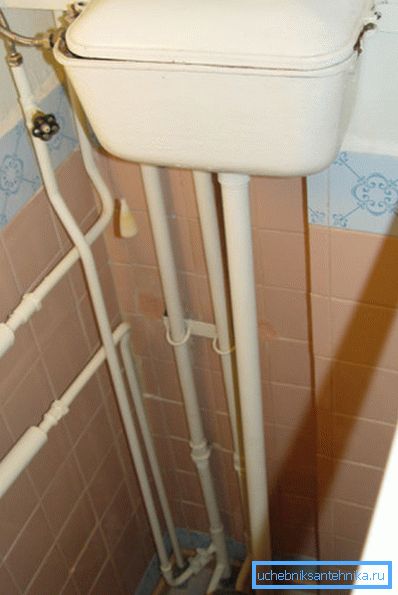
In this article we will look at the main differences between the old and the new options and tell you how to eliminate the most common breakdowns and faults with your own hands, especially since the work is very simple and does not require the use of special tools and accessories.
Features of old systems
The so-called "Soviet" modifications have a number of differences from the modern versions, consider the most significant of them:
| Unattractive appearance | A few decades ago, little was taken care of for its attractiveness; the focus was on the practical side: the reliability of each node and its efficiency. Therefore, the old tanks look not very aesthetically pleasing: primitive form, roughly treated surface |
| Tank location | In most cases, the container is located under the ceiling, and the water goes through the riser pipe. This allows the water flow to gain high speed and provide a high-quality flush, but this is accompanied by noise, you can also find compact options, but they are quite rare. |
| Design features of valves | The flushing system in such products is very distinctive and is based on the principle of the rocker when it is necessary to pull a chain or rope. The device of an old-style toilet cistern is simple, no assembly instructions are required - everything is clear even to those who see such a system for the first time. |
| High water consumption | Previously, no one bothered the issue of water consumption, so in such constructions there are no economical drain modes, the system always drains the entire volume, which, you see, is not very convenient and impractical |
| Intake system | In all older models, water is supplied exclusively from the side, other options are simply not used, this is both a plus, because everything is unified, and a minus - because the hoses can not be hidden, and they will always be visible |

Tip! Sometimes it is much easier to change the tank for a more modern one than to repair it. The decision is made in each specific case - if the scale of damage to the elements is large, then it may take too much time and money to repair them.
Design differences and typical faults
Consider the difference between the old and modern versions, especially since the difference is fundamental and significantly affects the operation of the system.
Device
To figure out how to repair the old-style toilet cistern, you need to know the main features of its device and the principles on which the entire system works:
- Faience (less often) and cast iron (more often) act as a material for the manufacture of the body. The use of a metal container suggests corrosive processes on the surface, so the tank must be periodically tinted on the outside and cleaned from the inside, otherwise rust particles may clog some elements, which will cause a breakdown.
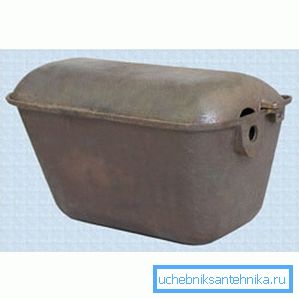
- The trigger lever is located either on the left or on the front, the water supply is usually on the right side.. To ensure smooth operation and eliminate leaks, it is best to immediately replace the eyeliner - modern flexible options cost a little and serve for a very long time.
- The tank is connected to the toilet by a steel pipe, the length of which can vary. Many developers to improve the aesthetic appeal of reducing its length, this option looks much better.
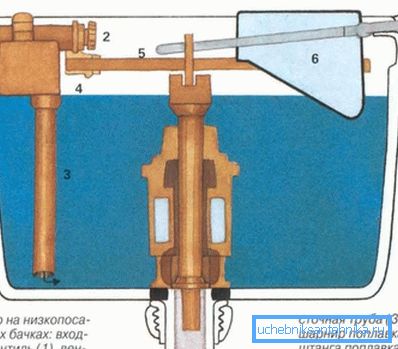
- The system works on the principle of the yoke: when you pull the chain, the cast-iron bell is raised and the water is released, when the handle is released, the system closes under its own weight. The water level is controlled by a float connected via a rod with an inlet valve - the system is simple and therefore reliable and effective, the minimum of parts ensures its long life.
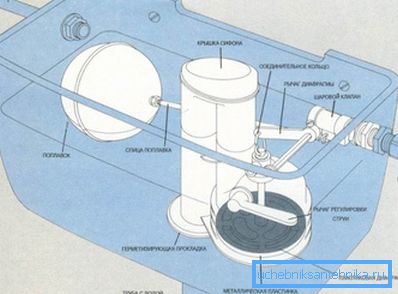
Features of the repair work
As a rule, the nature of breakdowns in the devices of the group in question is typical, therefore, we consider the most common faults and ways to eliminate them:
- Every few years, a pad of soft rubber that is installed at the outlet, becomes unusable or is simply torn, because of which water constantly flows into the toilet. The solution to the problem is simple: the replacement of the sealing element, and it can be cut out of rubber and independently on the size of the old worn-out element.

- Overflow, which is made of cast iron in the form of a bell, for several decades of work is covered with a layer of rust and other deposits, because of which the effectiveness of flushing is markedly reduced.
Tip: The problem is solved quite simply: the element is removed, burned on the fire and tapped with a hammer, after which the overflow is installed in place, while it is better to change all sealing elements at the same time.
- Permanent outflow of water through the drainage channel is caused by damage to the float. In this case, it is quite difficult to find a replacement, so the float must be soldered or sealed to restore integrity. Sometimes violations of this kind are caused by the fact that the bar is bent, it can be straightened - and the system will work.
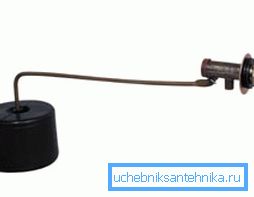
- If you want to figure out how to fix the old-style toilet cistern in which the system stopped working due to connection failures, then you need to understand that many of the mates are made of rigid wires in the form of hitch, they can break or become uncoupled. They can be easily made with your own hands, restoring the system to work in a few minutes.
- And finally, during prolonged use, the water intake system (especially if it is rusty) can become clogged. In this case, the need to clean the intake assembly, most often this is enough to restore performance.
Conclusion
In fact, repairing an old-style toilet cistern is much easier than modern options. This is due to the simplicity of the system and the reliability of all its components (see also the article Valve for the cistern - types and methods of repair).
The video in this article will clearly show some features of the work.